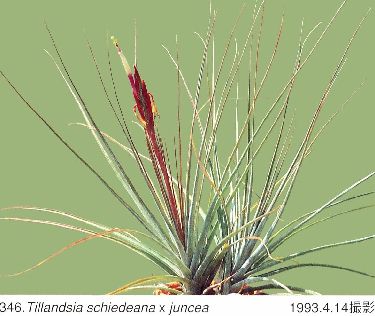
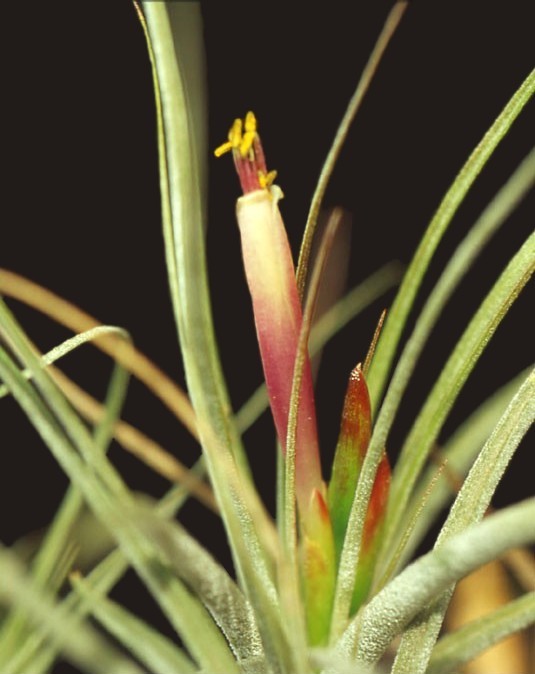
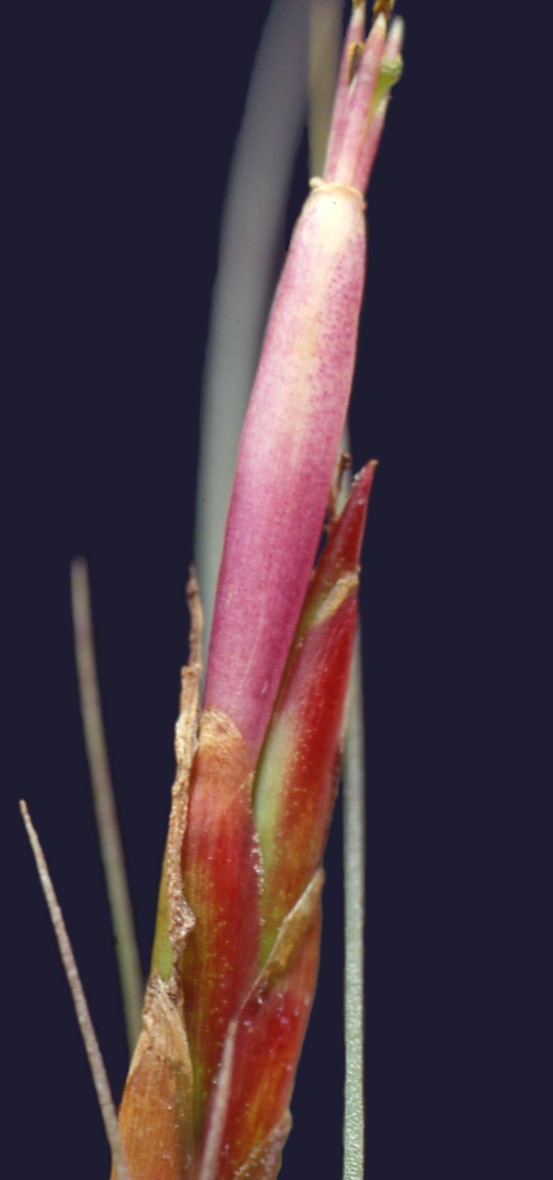
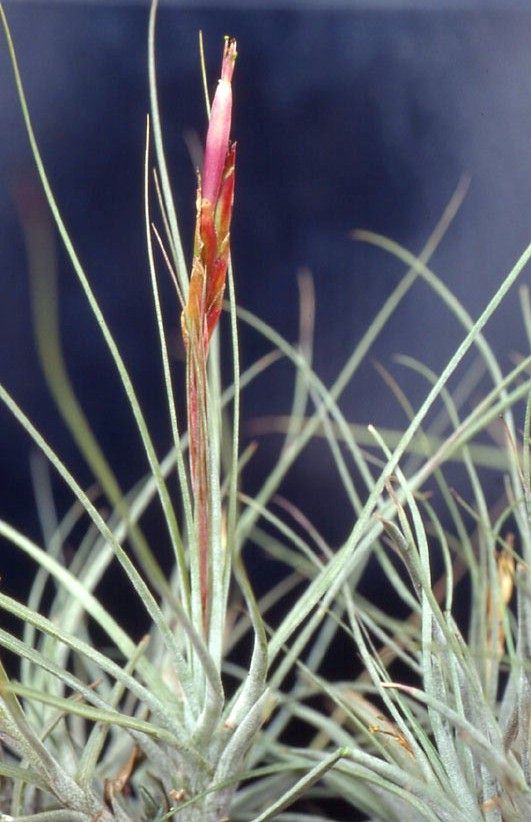
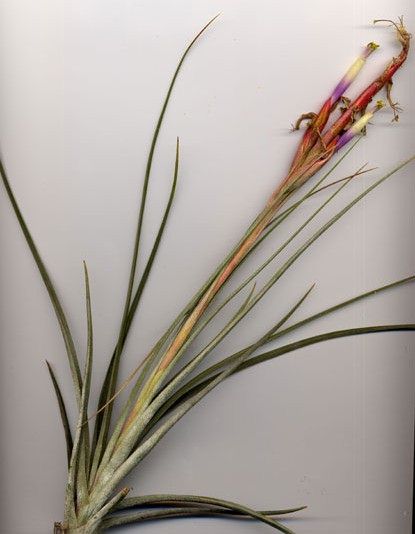
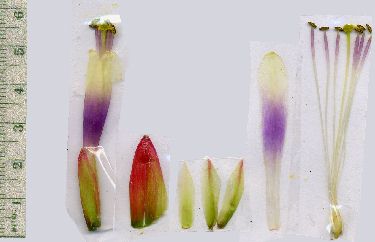
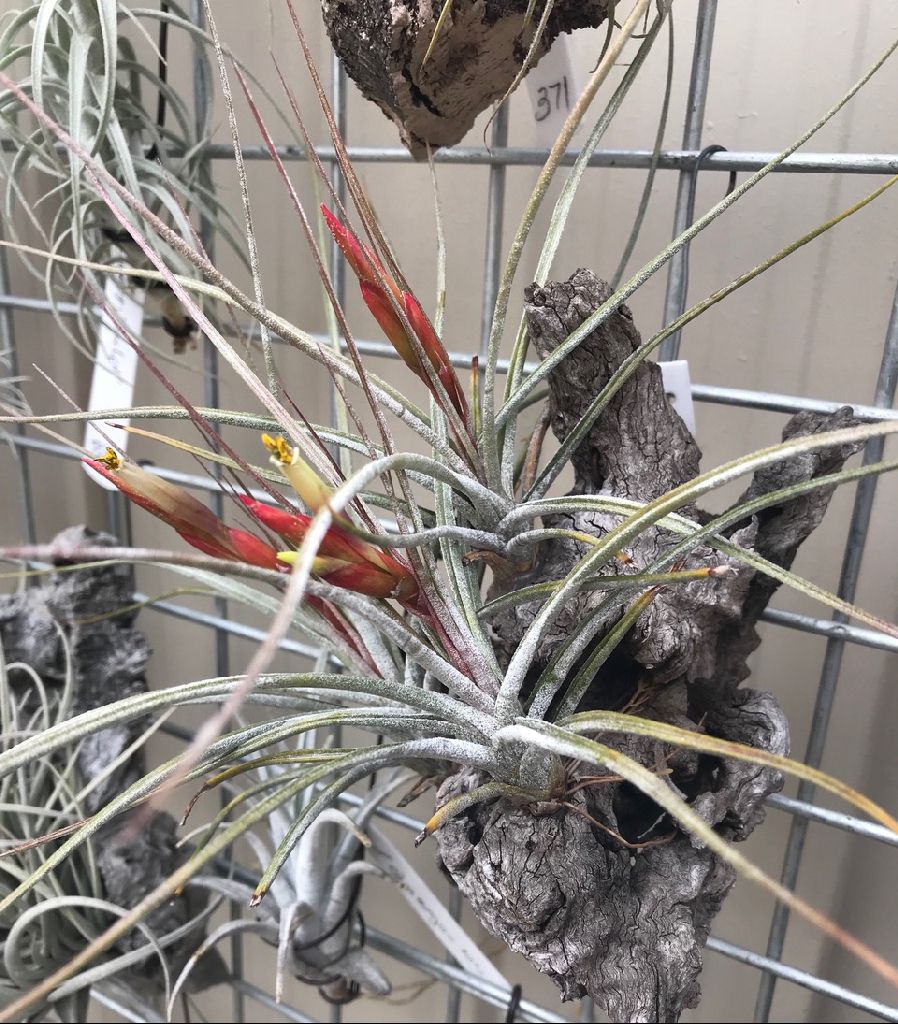
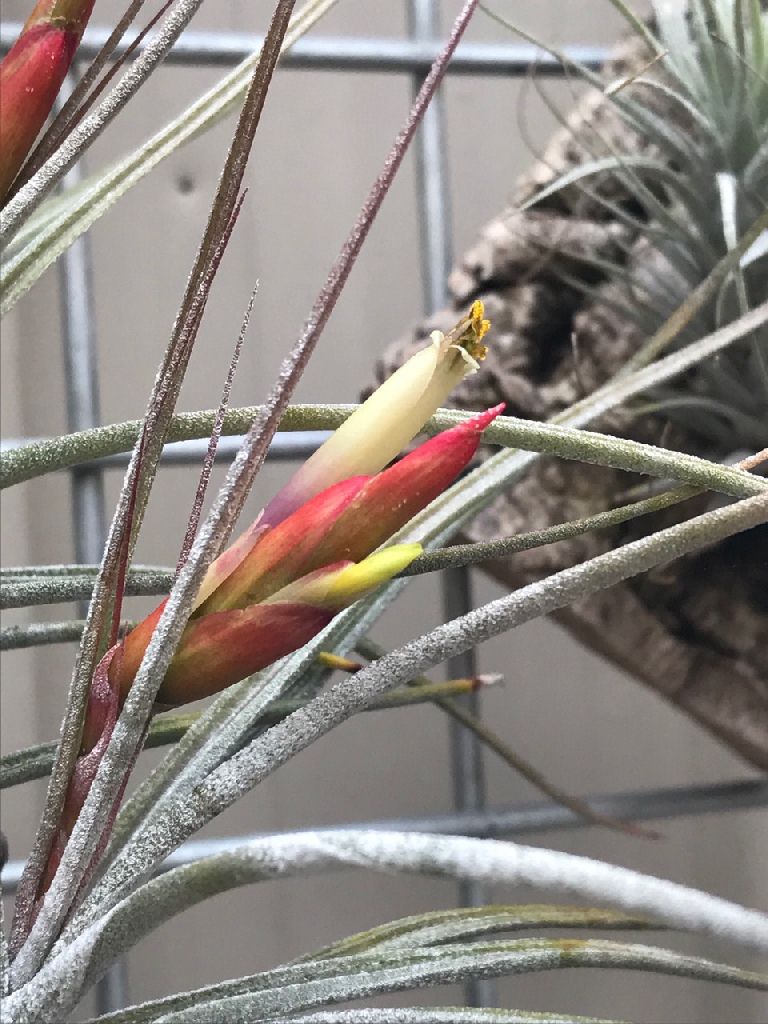
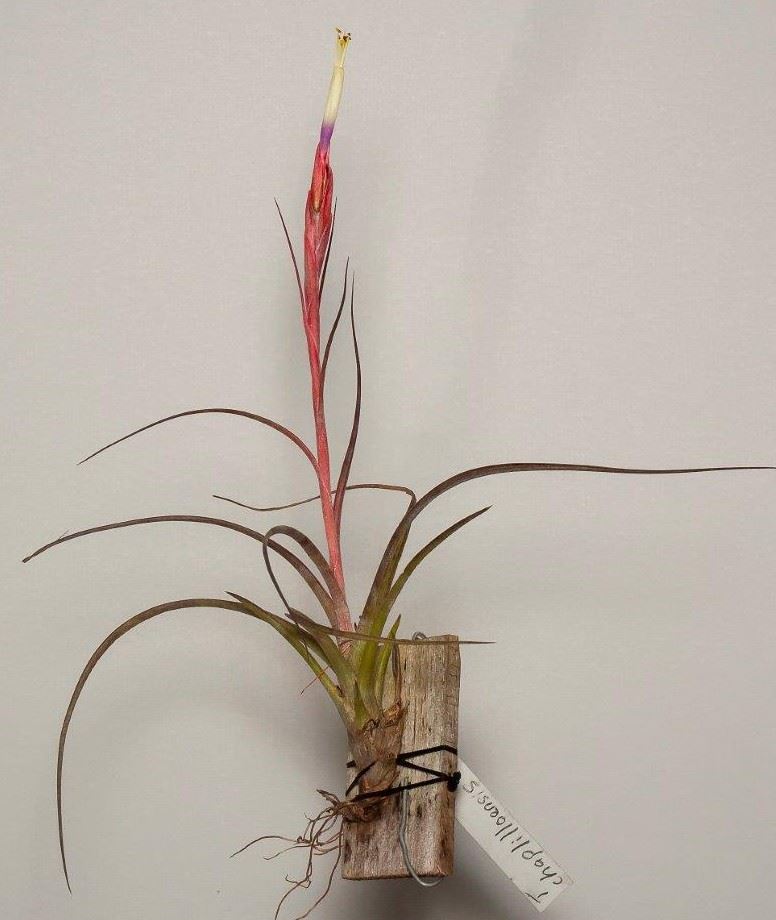
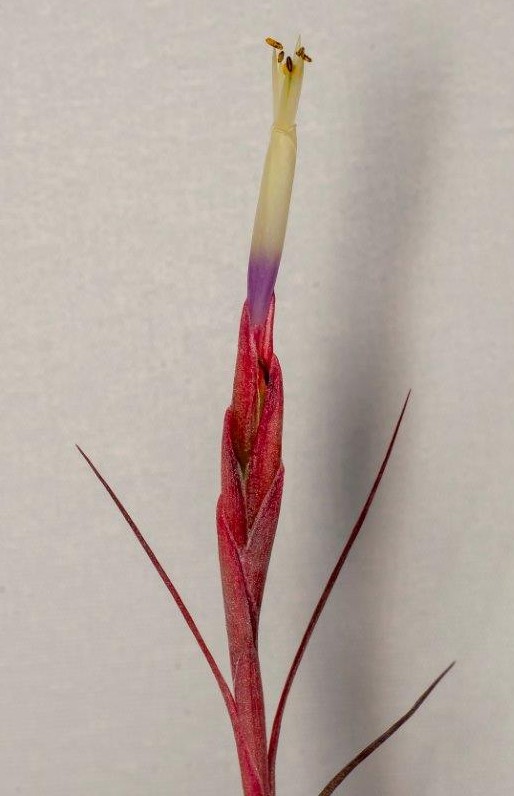
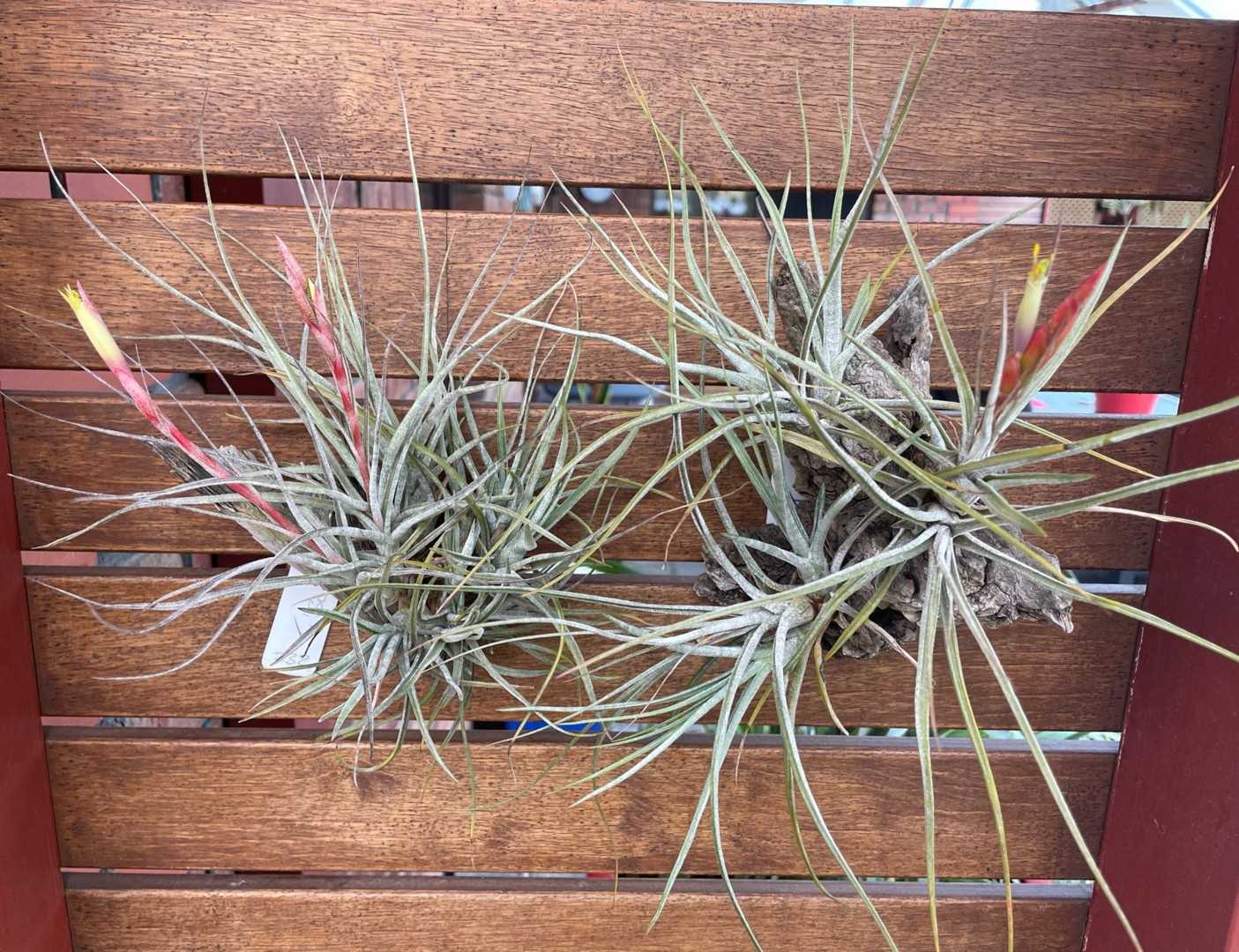
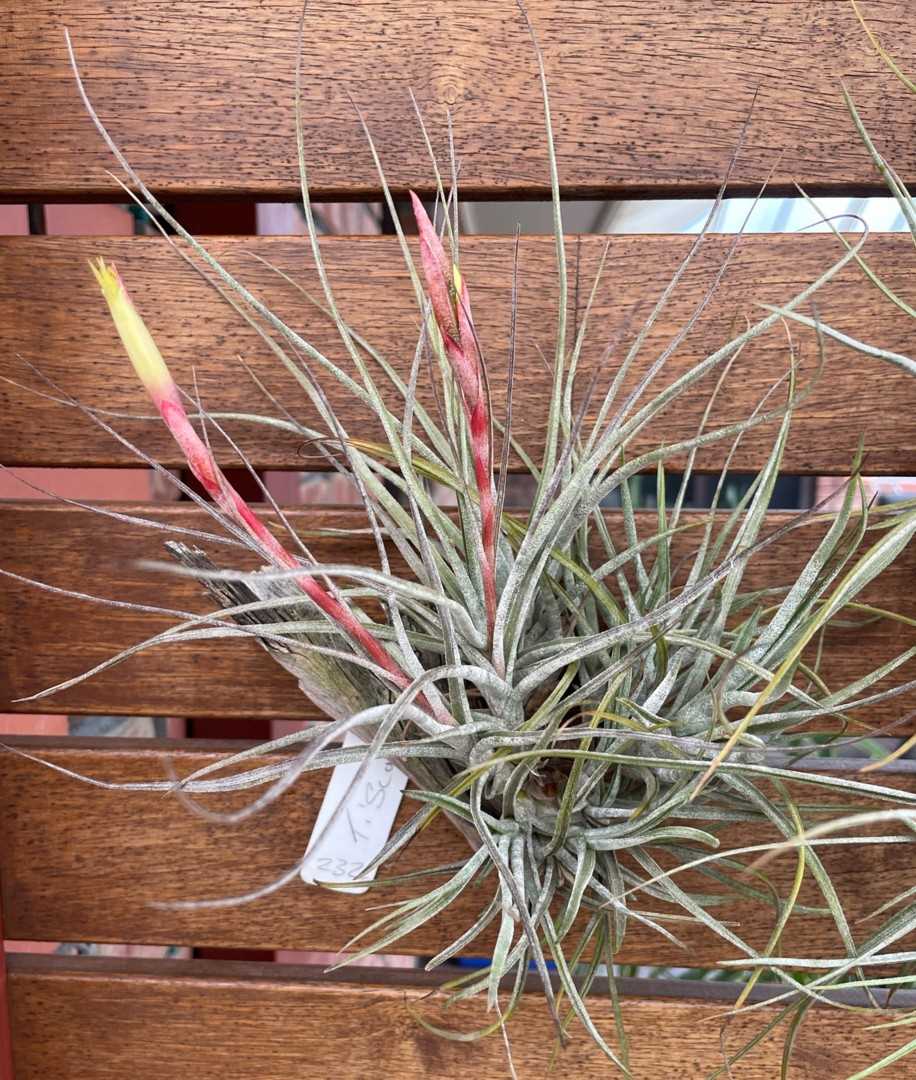
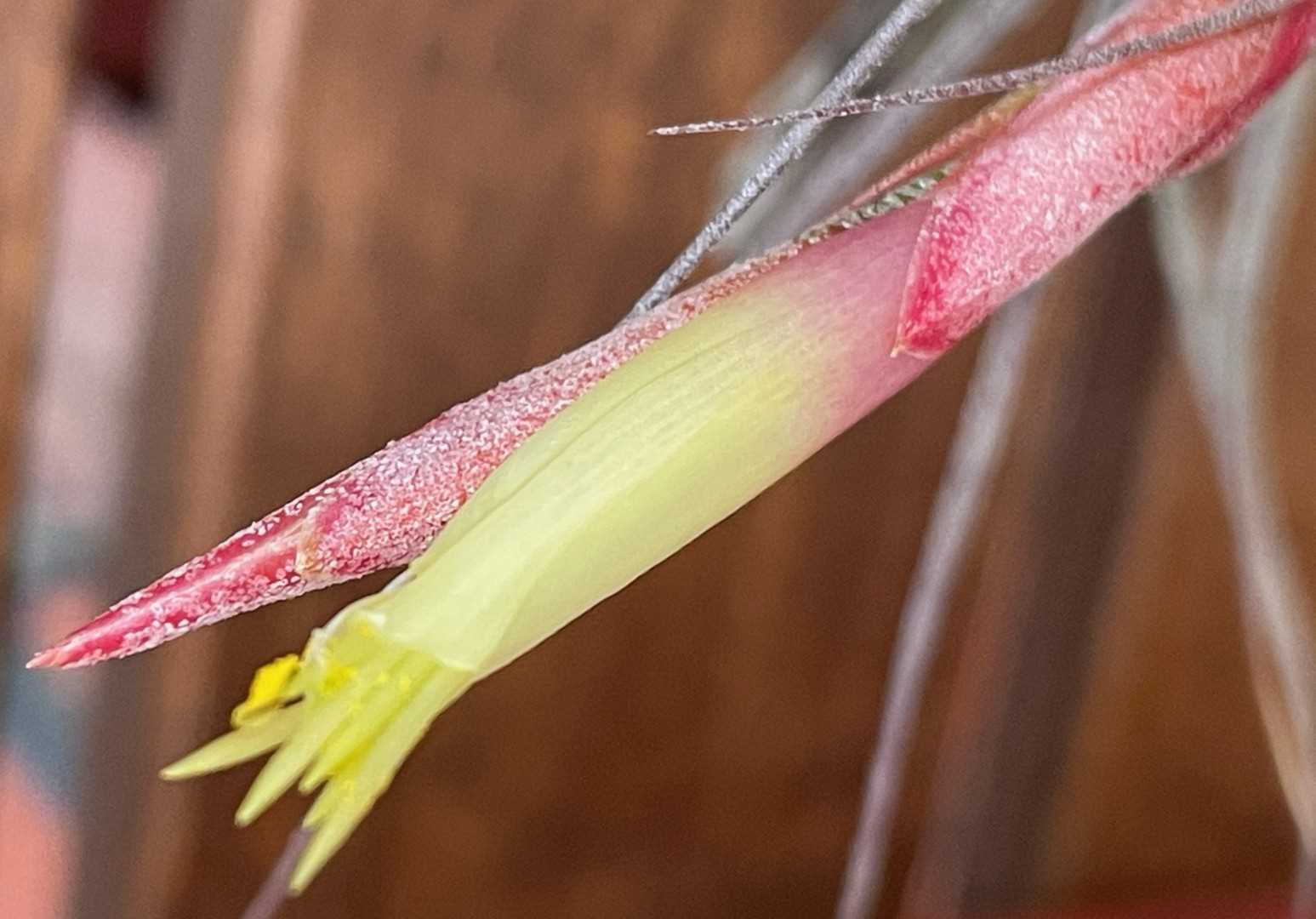
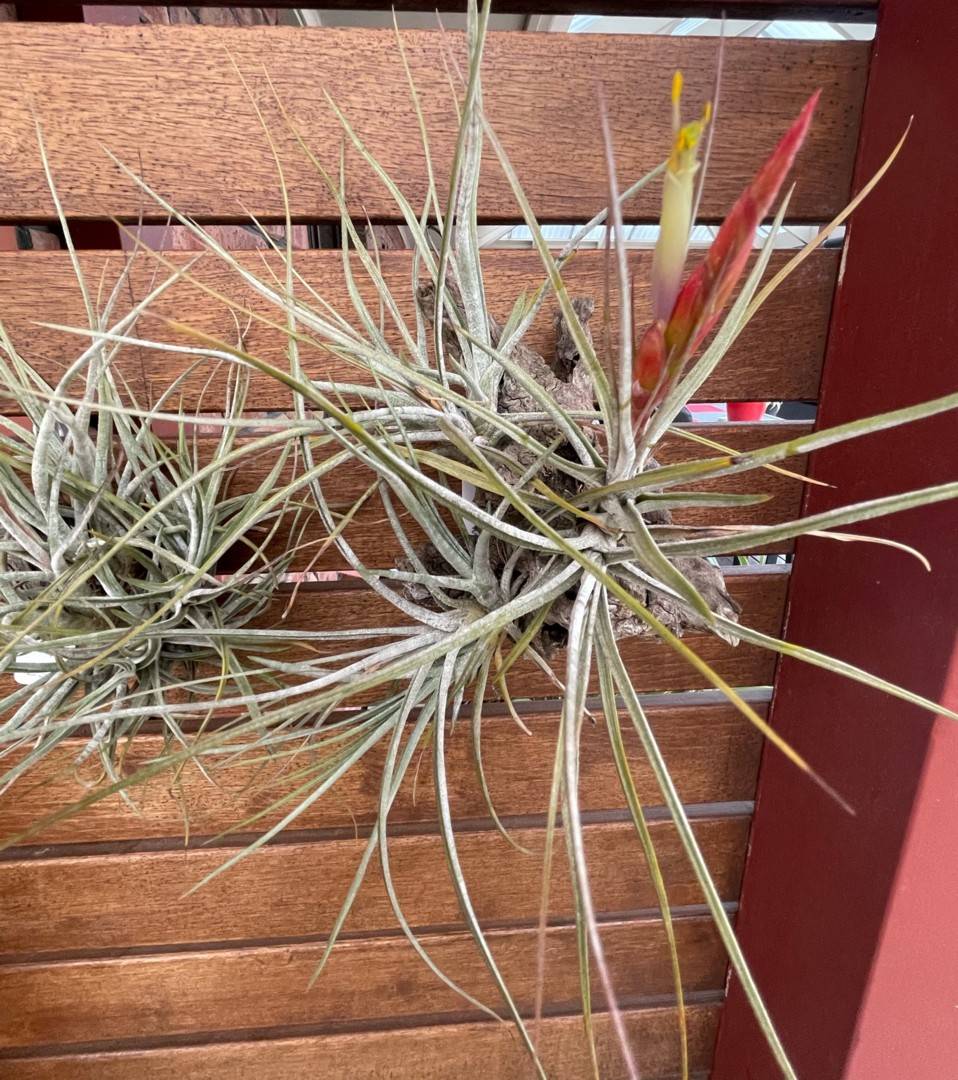
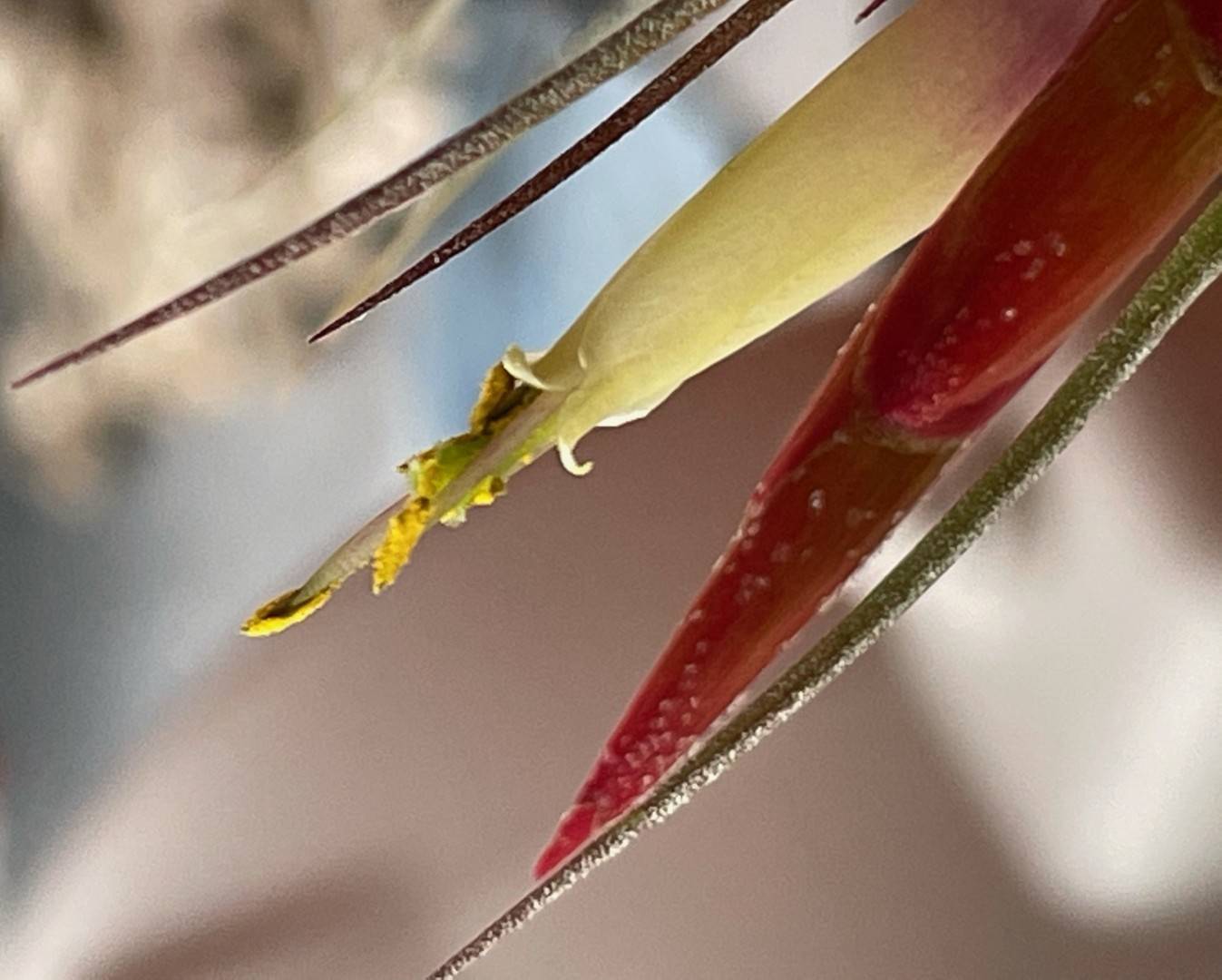
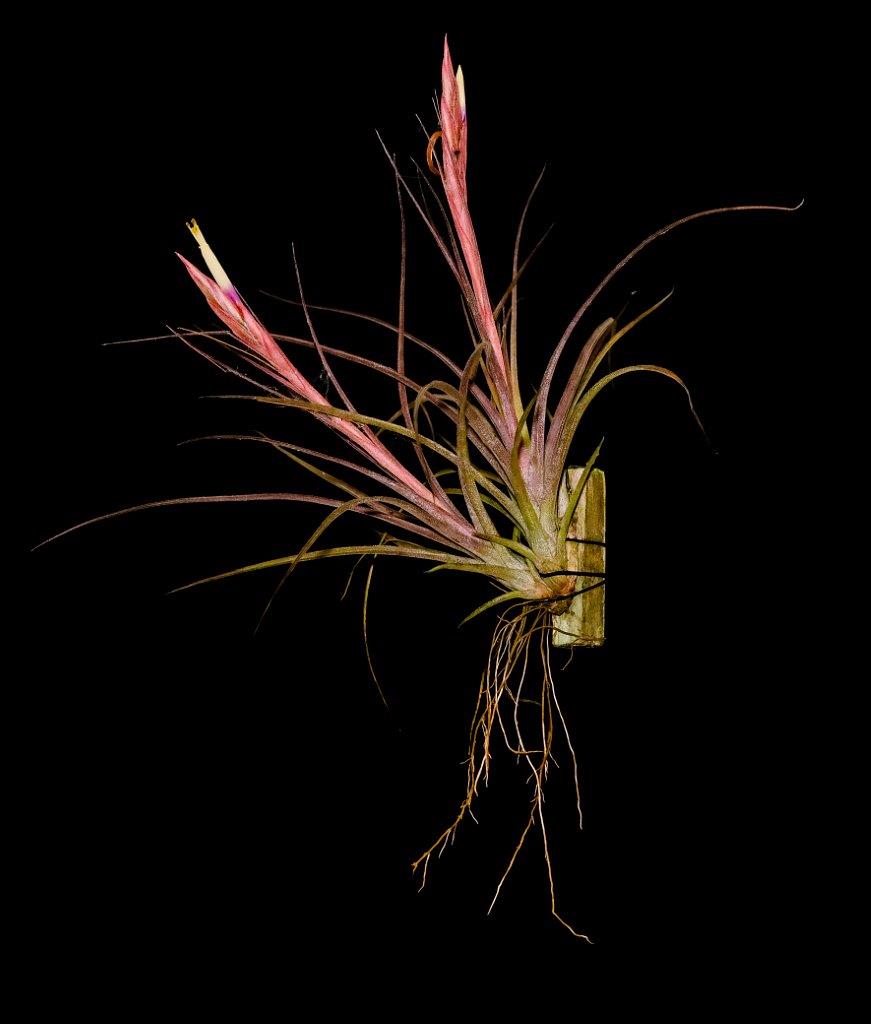
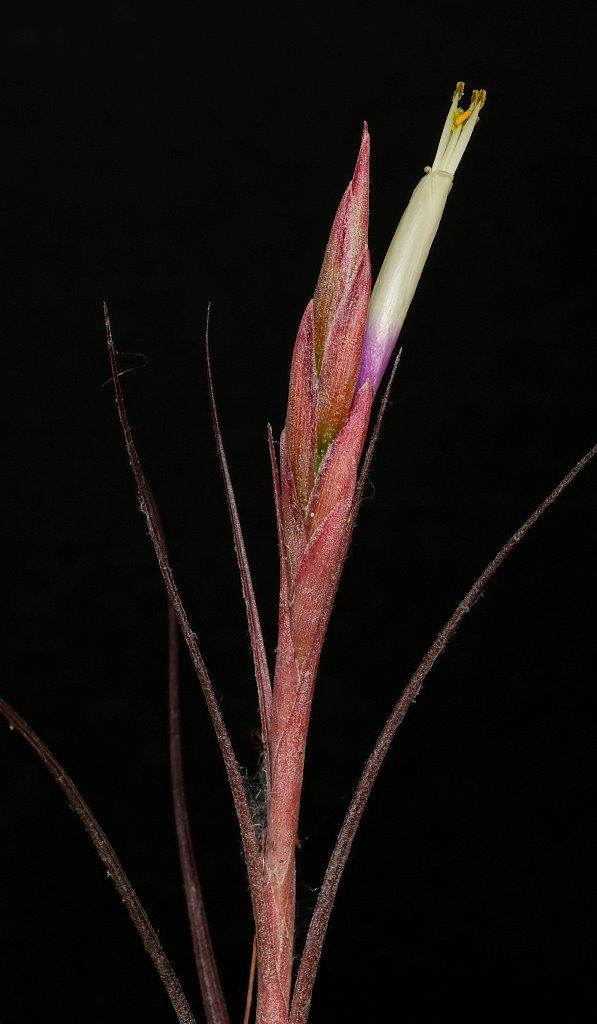
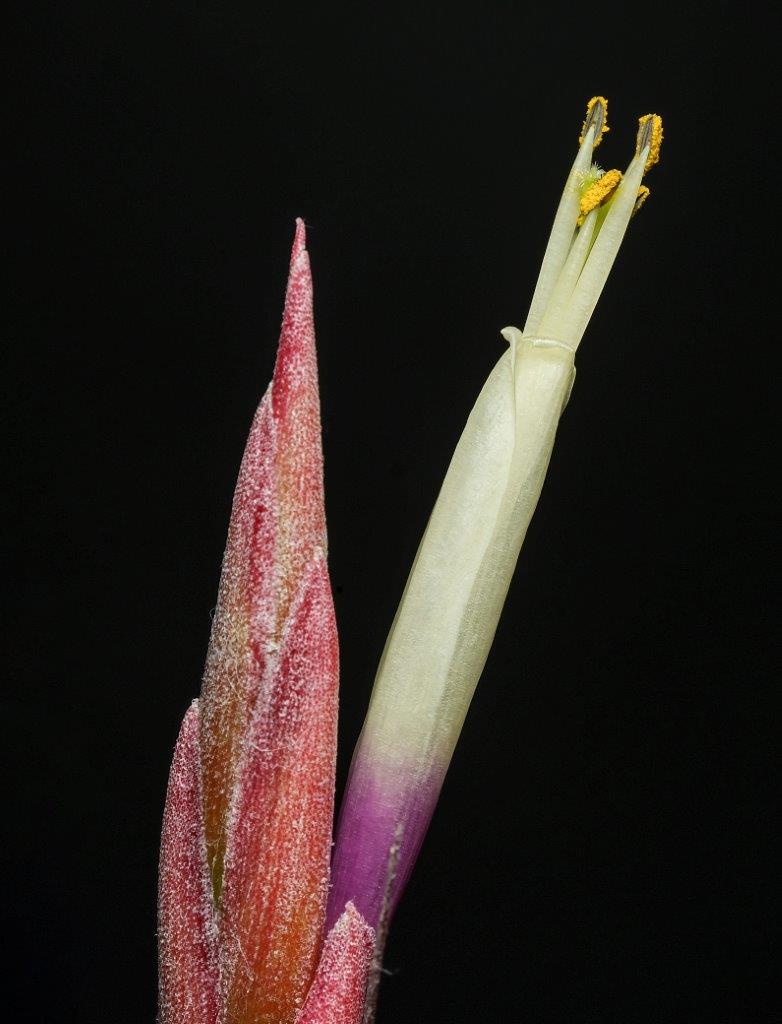
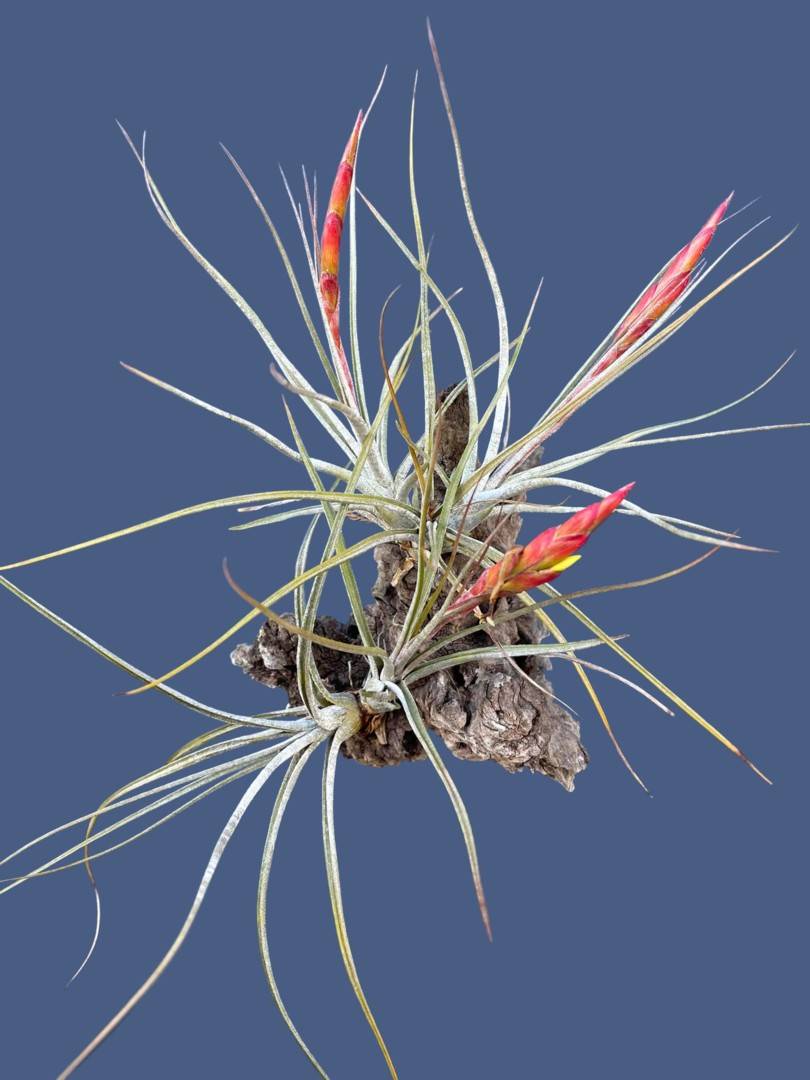
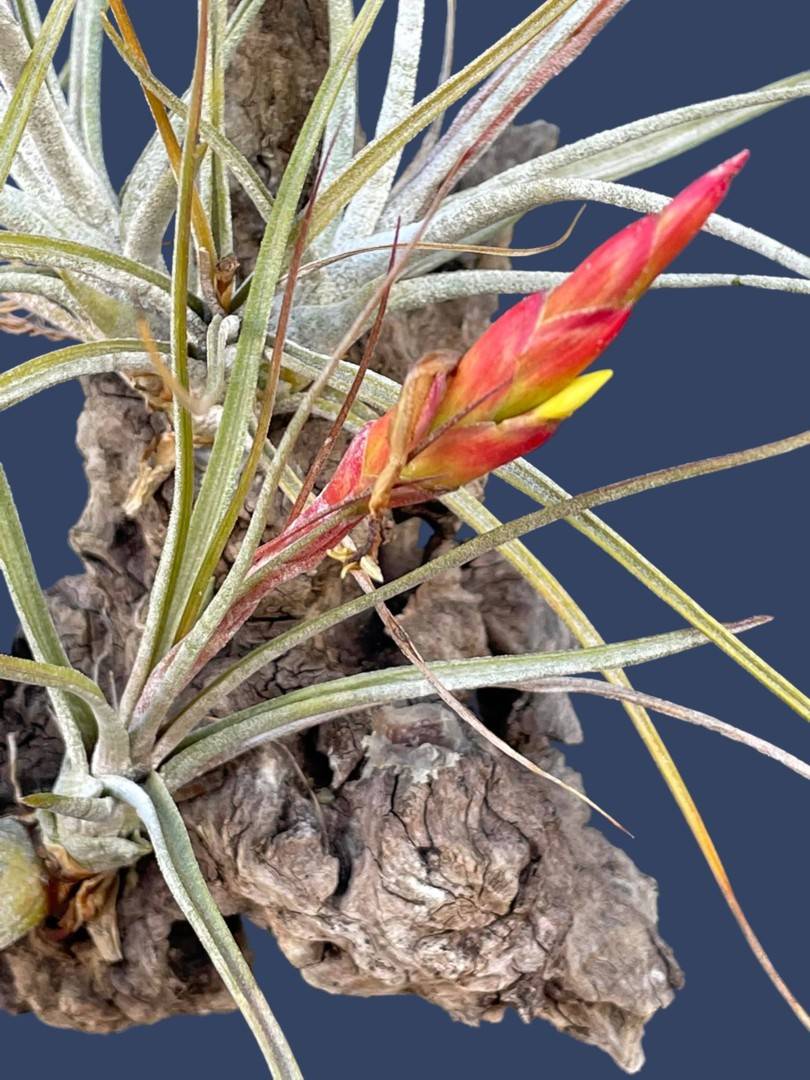
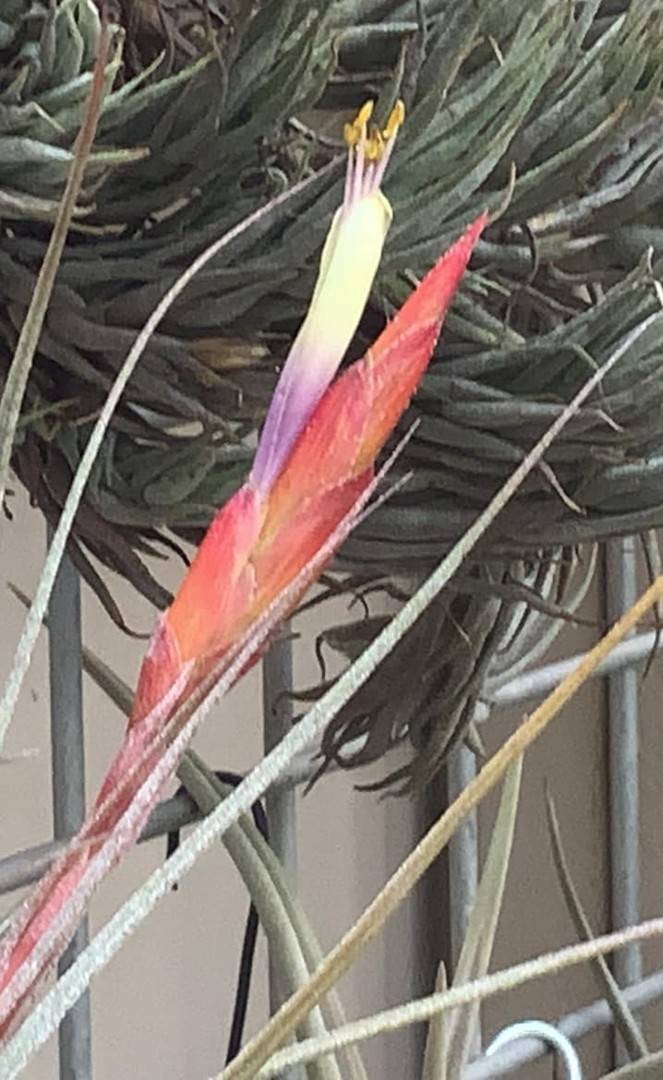
This belief caused much discussion before T. chapalillaensis (P 28, 29 PHOTOS) was published in J Brom Soc 61(4): 169-173. 2011. The following discussion from Renate Ehlers shows the decision to publish was not taken lightly.
“I originally obtained this Tillandsia in 1992 from my friend Jürgen Lautner, Goettingen, Germany, who discovered the plant on his trip to Mexico in 1992. He thought this was a new species which I should describe. But when I saw the flowers, I was nearly certain, that it was a hybrid. The two-coloured petals seem to be a sign of hybrid origin. Juergen insisted that this plant is very common near Chapalilla and that he did not see any putative parents for a hybrid. – But I did not trust him! Nevertheless I made a description which I gave Dr. Walter Till in May 1992. He commented that he thinks this is a hybrid between T. juncea and T. schiedeana. (P 30 PHOTO) I told Juergen his opinion which I shared, and that I cannot publish his plant as it is a hybrid. The plant grew very well in our collection and flowered several times. And Juergen had many little tillandsias growing pretty well from seed in the Botanical Garden in Goettingen and in his own collection.
In 2004 I was on a trip in Mexico with Juergen and Ulrich Lautner, Manfred Kretz and Wolfgang Schindhelm. On February 18th, we were driving from Puerto Vallarta in direction of Tepic on the MEX 15, and we intended to go to the area where Juergen found his dubious plant, and I was very curious. About 18 km before we reached Chapalilla, we saw the trees coated with many tillandsias. I really was very, very surprised when I saw, that this was THE PLANT, growing here by the thousands. It was not the same place where Juergen had collected his plants in March 1992, only the same area. The trees were crowded with the tillandsias, mostly growing in big clumps, but there also were single plants. We also found a few T. pseudosetacea, T. achyrostachys and T. makoyana and rarely T. ionantha.
The plant is growing in large numbers in this region, not only restricted to one location. There was not one T. schiedeana STEUDEL nor T. juncea SWARTZ growing at this location, and as well, we did not see any in the wider area. At the place where we collected, I would guess there were thousands of T. chapalillaensis, hundreds of T. pseudosetacea, tens of T. makoyana and T. achyrostachys and few T. ionantha.
Now I had to admit that Juergen Lautner was right: the plant is not a hybrid but a good new species. Maybe, or more likely, the plants are of hybrid origin. When a plant has densely populated a large area in such huge numbers and is fertile, it should be treated as a species, not as a hybrid. In the meantime, Juergen Lautner has adult seedlings from seed he collected in 1992, that flowered in the Botanical Garden of Goettingen several times, and they all look alike. He gave this plant to many other Botanical Gardens and collectors of bromeliads. They all flower every year and no other tillandsia brings so many fertile seeds, in my collection all plants growing in the surrounding of T. chapalillaensis often are covered with seeds.
Juergen and I had many discussions with friends about the plant and tried to solve the problem as to whether it is a hybrid or a species. Hiroyuki Takizawa wrote that he thinks that the putative hybrid on page 109 of the New Tillandsia Handbook by Hideo Shimizu and Hiroyuki Takizawa is the same plant as T. chapalillaensis, and I agreed that it looks similar. He got the plant from Alfredo Lau without location. But I believe that the plant shown on page 109 is closer to a hybrid that we found in the Sierra El Tuito. This is recorded in the Natural hybrids data base on http://fcbs.org as T. schiedeana x query. (P31 – 33. PHOTOS) Derek Butcher did a lot of investigation of hybrids, and just now in the wintertime he sent photos of putative T. schiedeana-hybrids to me for discussion, and so he made me start working again and finishing the article.
And I think, the Journal is the best place to publish the plant. We give the exact locality, where the plant is growing, hoping that some other collectors who come to this area, may be going to Puerto Vallarta, will take the chance to check, and may be they can write about their impressions in THE JOURNAL some day. And maybe there will be some more discussion about the evolution of a species and when is it classified as a natural hybrid.
After checking the description and history of T. chapalillaensis Hiro Takizawa commented: “I guess there are many natural hybrids amongst Tillandsia which are believed to be species. Natural hybridizing is a part of evolution. When does a hybrid become a species?" This is an interesting question and not easy to answer. A large population is important, especially for consideration as a species. Maybe some hybrids grow better than the parents and make large populations. Then it becomes a species!
Eric Gouda also contributed to the discussion. He has a number of seedlings from the Botanical Garden Goettingen from the first collection in 1992 of Jürgen Lautner, and so he was able to study the plant. He suggested that there seems to be slight differences in the seedlings but agreed to treat it as a species, as it has such a large population.”




Plant stemless or with a very short caulescent base, flowering 25-35 cm high, up to 25 cm wide, forming a rosette, sometimes simple, often growing in big groups.
Leaves polystichous-ranked, to 25 cm long, mostly straight and not or little spreading, very rigid, hard and sub-succulent, breaking easily, densely covered with cinereous adpressed scales
Sheaths 2 -2,5 cm long, 2,5 cm wide at the base, ovate-triangular, slightly subinflated and densely imbricate, enveloping half of the base of the plant, conspicuous, adaxially light brown, abaxially rugose, brown, both sides densely covered with brownish-grey big scales, the margins with big asymmetric trichomes
Blades 8-10 mm wide above the sheath, narrowly triangular, tapering in a long filiform apex, to 25 cm long, the lower ones reduced, involute-subulate, channeled, spreading, adaxially slightly 2- keeled, dark green, cinereous lepidote, abaxially more, the margins with very small asymmetric trichomes, appearing grey.
Peduncle erect, shorter than the leaves, 10-15 cm long, 4 mm wide, imbricately covered by few, foliaceous peduncle bracts, the sheaths of the lower ones 3 cm long with to 15 cm long blades, the upper ones with sheaths 2 cm long and the blades reduced towards the top, the sheaths red lepidote, the blades grey.
Inflorescence about as long as the rosette, simple or sometimes bipinnately composed of 2-3 spikes, (1 or 2 lateral smaller erect spikes), appressed at the base of the main-spike, primary bracts of the lateral spikes with sheaths about half as long as the spike and blades about as long as the spike, erect, covering the flat side of the spike, spikes distichous, 3-8 cm long 5-11 mm wide, lanceolate attenuate, not complanate but slightly terete, composed of 3-9 imbricate sessile flowers with 1-2 sterile bracts at the base, internodes about 1 cm, rhachis not visible.
Floral bracts 20-30 mm long, 10-15 mm wide, exceeding the sepals, broadly ovate, obtuse, ecarinate, rigid with thin margins, adaxially glabrous, nerved, abaxially lustrous, base green apical half red, sparsely lepidote with grey trichomes.
Sepals 18-21 mm long, 4-5 mm wide, lanceolate, acute, yellow-green with red tips, glabrous, even, the adaxial ones connate for 3-7 mm.
Petals 4,6-5 cm long, 8 mm wide at the top, 3,5 mm wide at the base, ligulate with sinus, forming an erect tube, corolla-throat closed, the tips very slightly curled back, apical 10-12 mm yellow-white, middle part 10 – 12 mm lavender, base white.
Stamens exserted, filaments 50-55 mm long, in 2 circles of unequal length, broadened near apex 0,8 mm wide, apical 8-9 mm lavender, white towards base, anthers 3 mm long, 1 mm wide, fixed 1/2-1/3 from base, brown, pollen yellow.
Style 45 mm long, whitish becoming yellow towards apex, stigma 15 mm high, 2 mm wide lobes erect, papillose, emerald-green, Type I Brown & Gilmartin.
Ovary 9 mm high, 2,5 mm wide at base, conical, whitish green.
Type-location: Mexico, Estado Nayarit, near Chapalilla, South of Tepic, Mexican Highway 15, km 18/19, 1300 m, Holotype collected by Renate Ehlers EM 041501, 18. 2. 2004. The plants grow on oaktrees with T. pseudosetacea EHLERS, T. makoyana BAKER, T. ionantha PLANCHON and T. achyrostachys E. MORREN.
The plant seems related to T. schiedeana STEUDEL but differs by the following characters:
Plant larger, not caulescent or nearly so, leaves are longer and wider, the blades long filiform-attenuate not acute, much harder and sub-succulent, the blades less spreading, inflorescence not always simple but sometimes digitately composed of 2-3 spikes, spikes less terete, wider, floral bracts wider, not strongly nerved, sepals less connate, petals longer, not totally yellow but the upper part yellow, the middle part lavender and the base white.
History: I originally obtained this Tillandsia in 1992 from my friend Jürgen Lautner, Goettingen, Germany, who discovered the plant on his trip to Mexico in 1992. He thought this was a new species which I should describe. But when I saw the flowers, I was nearly certain, that it was a hybrid. The two-coloured petals seem to be a sign of hybrid origin. Juergen insisted that this plant is very common near Chapalilla and that he did not see any putative parents for a hybrid. – But I did not trust him! Nevertheless I made a description which I gave Dr. Walter Till in May 1992. He commented that he thinks this is a hybrid between T. juncea and T. schiedeana. I told Juergen his opinion which I shared, and that I can not publish his plant as it is a hybrid. The plant grew very well in our collection and flowered several times. And Juergen had many little tillandsias growing pretty well from seed in the Botanical Garden in Goettingen and in his own collection.
In 2004 I was on a trip in Mexico with Juergen and Ulrich Lautner, Manfred Kretz and Wolfgang Schindhelm. On February 18th, we were driving from Puerto Vallarta in direction of Tepic on the MEX 15, and we intended to go to the area where Juergen found his dubious plant, and I was very curious. About 18 km before we reached Chapalilla, we saw the trees coated with many tillandsias. I really was very, very surprised when I saw, that this was THE PLANT, growing here by the thousands. It was not the same place where Juergen had collected his plants in March 1992, only the same area. The trees were crowded with the tillandsias, mostly growing in big clumps, but there also were single plants. We also found a few T. pseudosetacea, T. achyrostachys and T. makoyana and rarely T. ionantha.
The plant is growing in large numbers in this region, not only restricted to one location. There was not one T. schiedeana STEUDEL nor T. juncea SWARTZ growing at this location, and as well, we did not see any in the wider area. At the place where we collected, I would guess there were thousands of T. chapalillaensis, hundreds of T. pseudosetacea, tens of T. makoyana and T. achyrostachys and few T. ionantha.
Now I had to admit that Juergen Lautner was right: the plant is not a hybrid but a good new species. Maybe, or more likely, the plants are of hybrid origin. When a plant has densely populated a large area in such huge numbers and is fertile, it should be treated as a species, not as a hybrid. In the meantime, Juergen Lautner has adult seedlings from seed he collected in 1992, that flowered in the Botanical Garden of Goettingen several times, and they all look alike. He gave this plant to many other Botanical Gardens and collectors of bromeliads.
They all flower every year and no other tillandsia brings so many fertile seeds, in my collection all plants growing in the surrounding of T. chapalillaensis often are covered with seeds.
Juergen and I had many discussions with friends about the plant and tried to solve the problem as to whether it is a hybrid or a species. Hiroyuki Takizawa wrote that he thinks that the putative hybrid on page 109 of the New Tillandsia Handbook by Hideo Shimizu and Hiroyuki Takizawa is the same plant as T. chapalillaensis, and I agreed that it looks similar. He got the plant from Alfredo Lau without location. But I believe that the plant shown on page 109 is closer to a hybrid that we found in the Sierra El Tuito. This is recorded in the Natural hybrids data base on http://fcbs.org as T. schiedeana x query. Derek Butcher did a lot of investigation of hybrids, and just now in the winter time he sent photos of putative T. schiedeana hybrids to me for discussion, and so he made me start working again and finishing the article.
And I think, the Journal is the best place to publish the plant. We give the exact locality, where the plant is growing, hoping that some other collectors who come to this area, may be going to Puerto Vallarta, will take the chance to check, and may be they can write about their impressions in THE JOURNAL some day. And maybe there will be some more discussion about the evolution of a species and when it is it classified as a natural hybrid.
After checking the description and history of T. chapalillaensis Hiro Takizawa commented: “I guess there are many natural hybrids amongst Tillandsia which are believed to be species. Natural hybridizing is a part of evolution. When does a hybrid become a species?" This is an interesting question and not easy to answer. A large population is important, especially for consideration as a species. Maybe some hybrids grow better than the parents and make large populations. Then it becomes a species!
Eric Gouda also contributed to the discussion. He has a number of seedlings from the Botanical Garden Goettingen from the first collection in 1992 of Jürgen Lautner, and so he was able to study the plant. He suggested that there seems to be slight differences in the seedlings but agreed to treat it as a species, as it has such a large population.
Tillandsia x schiedeana Steudel Sierra El Tuito
Mexico, Jalisco,Sierra El Tuito EM8177 and EM901603, Klaus & Renate Ehlers, 16. 3.1990
In March 1981 I was doing some fieldwork in the Sierra El Tuito, near Puerto Vallarta with my husband Klaus and my friends Gerda Haug and Guenther Noller. We came along a small river and saw a tree, covered with large clumps of T. schiedeana. We were surprised when we saw that the flowers were violet, not yellow as normal. So we collected some plants to take home, which flowered in May 1983 in our collection. The petals were reddish-violet with pale tips, not violet, as at the location. I tried to collect these plants again, when I was next in the area. Unfortunately I never could find that tree again. In March 1990 I again collected plants in the Sierra El Tuito, and these flowered in May 1992 in our collection. I also got seed, so the plants are fertile. These plants also had no violet petals, but showed tri-coloured ones, the tip whitish yellow, the middle part violet and the base white. My guess was that it must be a hybrid. What is very interesting: what may be the other parent? It is the area where we found a number of Tillandsias like: T. tillii EHLERS, T. bourgaei BAKER and T. juncea (RUIZ & PAVON ) POIRET. So the only putative partner for the T. schiedeana is T. juncea. On the other hand, the plants are smaller than the normal T. schiedeana growing in the area, while T. juncea has more than double size. Why should the hybrid be smaller than both of the parents? T. schiedeana is not very abundant in this region, except on the one tree which hosted so many plants. We only found some specimens in other trees from time to time.
As mentioned in the information on T. chapalillaensis, the hybrid on page 109 of the New Tillandsia Handbook from Hideo Shimizu and Hiroyuki Takizawa seems to be very similar to this plant from Sierra El Tuito.
We thank all my friends who co-operated with me, especially Eric Gouda and Hiroyuki Takizawa and last, but not least I want to thank Derek Butcher, who did a lot of investigation, we exchanged many e-mails, he sent photos of hybrids and we had a lot of discussions and he gave his advice and corrections. Many thanks to Dr Klaus Eistetter who corrected this article.
Our best thanks to Dr. Walter Till, University of Vienna for his cooperation, help and for the Latin diagnosis.